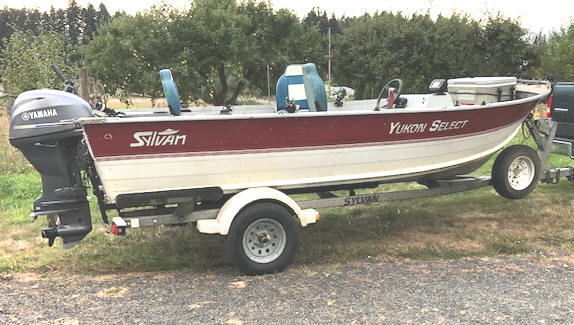
a 1994 16' Sylvan Aluminum Boat
 |
Modifying
& Outfitting a 1994 16' Sylvan Aluminum Boat
|
I thought I would never sell my 2005 18' North River Mariner boat, which in I
purchased used in 2009, where I had taken a basic bare boat and over the years
(16) that I owned it, I had made it into a real fishing machine.
However with health issues creeping up on me, (bad lower back issues, COPD and
wet Macular Degeneration) along with where I had not gotten this boat's bottom wet in
over 2 years because of my low back issues. All this, and my age (89), my
priorities have changed considerably, along with the fact that about all my fishing partners
have passed away, OR the younger ones own their own boats. My son is
so busy in his business that he can't take much time off, and the grandsons are
scattered. I have tried to introduce younger people into my style of
fishing, but they also have a life that oftentimes interferes with fishing.
Therefore, I very OFTEN fish alone, (at the dismay of my adult kids) then again,
I am sure that a smaller/lighter boat would be easier to handle alone at
launch/recovery time for this old GEEZER. However on any of my boats, I have about all the safety provisions
there, and they are OPERTIVE.
Now instead of ocean fishing being one of my prime spots, my sights
have turned to Puget Sound, or the local bays, / tidewater, lower river sections in the fall for
returning salmon. This change is mainly due to the salmon seem to have
moved out into DEEPER/COLDER ocean water which means longer runs offshore (like
25 + miles one way) and if it gets rough in the afternoon on the way back in, not so good on my
low back issues, as compared to 5-8 miles on smoother water in the bays and even less on
the rivers. This farther run is partly
because of water temperature, and feeding habits where the salmon follow the bait.
Then with my North River boat (which is not really a offshore boat) I have had to closely
watch the weather and timing with the tides, which cuts down on fishing time on the water, as
compared to if It was a larger Deep Vee rougher water boat.
These newer locations (but not foreign to me) will include the lower Columbia
River
(buoy 10), Columbia River upriver toWoodland, the Willapa Bay, the lower
(tidewater) Chehalis, and southern
Puget Sound, and thren closer to home, sections of the Cowlitz River. Then also this smaller boat
would also be more conducive to lake fishing.
I may miss the convertible cabin of the North River if the weather turns sour,
but in my older years, in all possibility, I will not be on the water much under those
conditions anyway. But then that is what rain gear was made for.
Enter Boat # 28 ;
(For a link explaining this
number CLICK HERE).
Maybe I should add here before we go to far here, is that I have owned, made and fished so many boats in my lifetime (89 years,
starting at age 10) that I understand quite well the needs for, and am able to
visualize what could be used to improve usage or comfort in boating
design/rigging. I am profoundly/considerably different than most in that if a product or accessory
is not available, I have the ability to fabricate it (or know someone who does),
as in my previous life I was a machinist. Then in my 20 plus years
of retirement, I still own a pretty well equipped machine shop. While other
boaters or fishermen accept how a boat is built or rigged, I an able to design and fabricate
a helpful improvement.
After doing a lot of looking for used boats, I had pretty much settled on a 16'
Smoker Craft Alaskan model. I have a friend who has fished one of these
alongside of me in the bays for years, so I was pretty well aware of what they were. These older boats are riveted, (not welded), but
are a lot better than older riveted aluminum Hewescraft boats I have owned in
the past. These joints between the sides and bottom appear to have a sandwiched in thin mastic seal
between them, along with a LOT of very close LARGE rivets, and
these hulls appear be made of a bit thicker material.
Looking at numerous boats online and relatively close to my residence
(100 miles), I also found some Sylvans pop
up. Well it just happens that they are both made by the same company. My guess is
the Smoker Craft is the flagship line while the Sylvan being more of the utility
version, but the basic hull design appears pretty much the same. Of the
four
available near me, I selected an older 1994 Sylvan Yukon Select version, which has 81" beam with
21" freeboard, (quite a bit for a 16' boat with a fuel tank under the floor) and with an open floor plan (no cross seats).
This boat was
powered by a 2012 40hp Yamaha and a T series (high thrust) 8hp Yamaha 4 stroke
outboards. This was an older boat than the others I looked at, however it
appeared used but not really abused, with no dents or leaks. But
with all things considered, (including the galvanized trailer), what swayed
me more than anything was it had a couple of newer, well known to be reliable motors,
as I had bought new and owned a Yamaha T8 for15 years (currently with 391 hours), which I just swapped onto this
new to me
boat, as I knew what condition it was in. Along with the fact that (1) I
was pushing a time frame to get this new boat to me on the water, chasing fall
Coho salmon. (2) Then on this new to me motor, it had a extra long shaft, which
would be a detriment if back trolling shallow river tailouts.
I later did minor work on the other T8 that I removed and placed it onto my
North River, replacing my own, and then put it (the North River) up for sale.
| Here you see it outfitted |
This boat was apparently originally set up for Columbia River
spring/fall Chinook and sturgeon fishing, evidenced by the Columbia
River type anchor system. This entails a rocker type anchor
securely mounted in a holder on the bow. The latest owner
apparently had little interest in this type of fishing, (being an Asian)
as he targeted crappie at night on the lower
Snake River, or an occasional crab outing on the lower Columbia River.
| Here you see the Columbia River anchor from above | Here you see the Columbia River anchor from the front, also visible are the bow/docking lights |
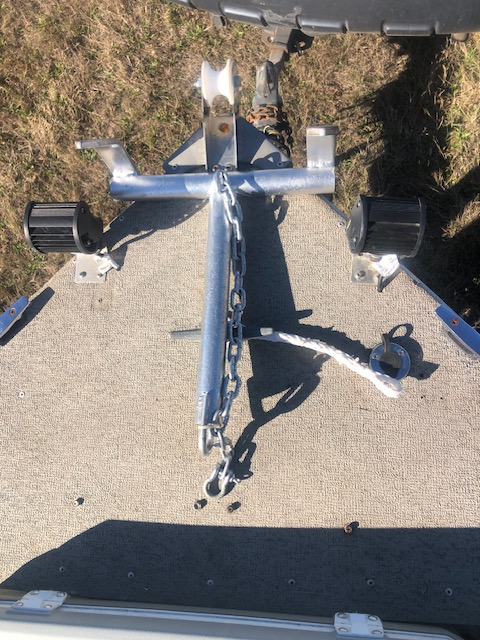 |
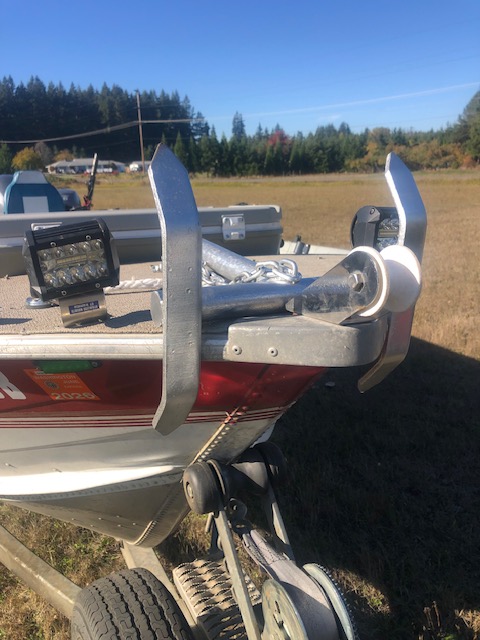 |
Again this boat was structurally sound, however maybe needing a
refresher
paint job somewhere down the road. But I quickly found (at least one) of a
previous owner's mechanical/electrical inability was less than minimal.
Almost all the wiring needs to be completely redone, because it all (other than the motor
itself) from the rear side mounted instrument panel to
the battery had been cut off under the splashwell near the transom.
The rod holders were not placed in convenient locations for my type of fishing, or if they were, they were scantily secured. It also came with a fitted canvas cover and a Bimini top (both of which I will probably never use).
The two side seats were mounted on 3/4" plywood lids of the metal storage box
bases, however the
wooden lids had shrunk/slightly
deteriorated to
where the hinge screws were loose. To make matters worse regular steel
nuts were used on the stainless bolts, which the nuts were so rusted that they had to be cut off with a Dremel tool. The sliding rail for the seats were
dinged, loose and corroded which needed cleaning and a slight amount of grease
added in the slider slot.
There is a moderate amount of storage under the seats, with
plenty of room here for a large plastic waterproof toolbox and another with safety
components, plus a First Aid Kit on the Starboard skipper's side. On the Port side, I will
use it for storage of personal inflatable life vests and extra rod holders. This box can also accommodate small tackle
bags, rain coats or lunch bags.
| Here you see the underside of the skippers seat with the waterproof safety storage underneath | |
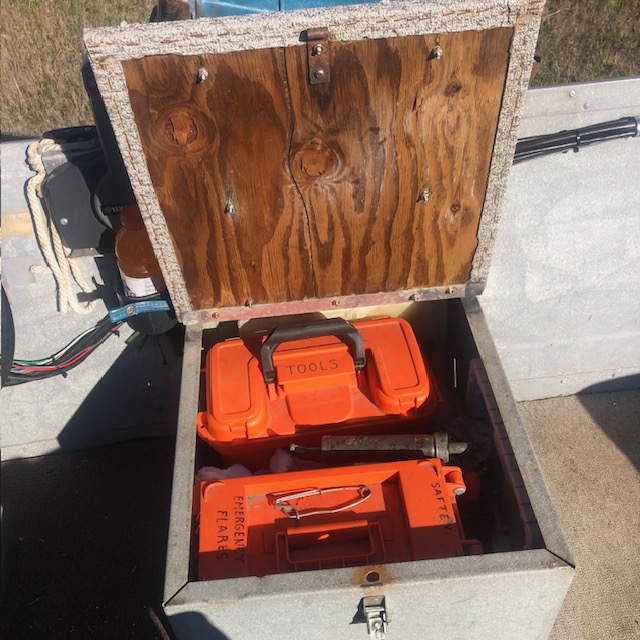 |
There is lots of storage in the bow semi raised area where a live-well could have occupied in the flagship line. This are has lots of full width storage. Here extra life preservers, rain gear, a couple of coats, collapsible paddles, even a spare prop. Farther forward there is minimal bow storage, mostly for the front removable bow navigation light.
At the rear sides, about 6" wide by 3 1/2' of inward and up near the gunnel, is a aluminum protrusion inward that also houses rear side flotation, here the top cover has a shallow 1" lip for a somewhat catchall tray, and where downrigger bases can be mounted in the forward part. As a note here, USCG requires any boat 19' and shorter has to have full floatation. There is flotation foam in the floor and this rear side floatation is probably needed to have it meet the specs.
But it had no real close to the fishing area any real "Catch All" type provisions that I like for
use of temporary fishing
gear type storage (changing terminal tackle). However I had already added a leader spool holder centered on the
forward lip of the splash well. This spool base now also forms a base for a 2 1/2" deep
by 7" X 10" wide 1/16" thick aluminum tray.
This tray sets in/on the leader spool base and is held in place by the 3/4"
dowel of the 1 12" dia. pipe insulation leader/hook foam. It (the tray) protrudes forward about
5" but
does not interfere with anything because directly below it is the forward
sloping door for entrance into the bilge that's footprint is forward of the
tray's front edge. This is not a true rectangular box, but the front two
corners have a1" wide 45 degree corner strip so that it does not have a sharp front corner in
case someone falls on it.
This tray was a challenge to bend, using only a carpenters square, sharpie felt pen, wood cutting bandsaw, large 6" machinists vise and a large rubber mallet. Then when formed, the other challenge was to get the holes for the retainer dowel aligned almost perfectly with the side holes in the base, as I wanted this tray as snug as possible. This was accomplished by placing it in desired location, using a sharpie felt pen to copy/draw the hole, hand drill a 3/8" hole in the center, then using a Dremel tool and small cutter to remove most of the hole. Then install the tray and using a small 1/2 round file, enlarge this hole to match the base hole, which took a lot of trial and error. Once finished, I had the corners welded, and vinyl tubing split lengthwise for an protective edging.
| Here you see the leader spool/catchall tray |
And there was no provision for a fishbox of any
kind.
It also did not have any side mooring cleats amidships or
on the stern. Which are
critical for when fishing solo, like when leaving the boat tied up to the dock while
parking/retrieving the trailer. Here, I
also use the rear cleat that is offside of the trolling motor to secure the fish
bleeding rope.
And when I was up under the bow deck to rewire the navigation and docking bow lights I found something rather disturbing, the large center bow mooring cleat did not have any backing plates under the plywood, NOR did they have any nuts on it's bolts. The front side cleats were installed with just wood screws, (non stainless) as they are so close to the gunnel that there is no way to get nuts on any bolts there. Obviously not to be used for using tied to moorage and left for any length of time, but maybe Okay for securing bumpers.
| Here you see it underway |
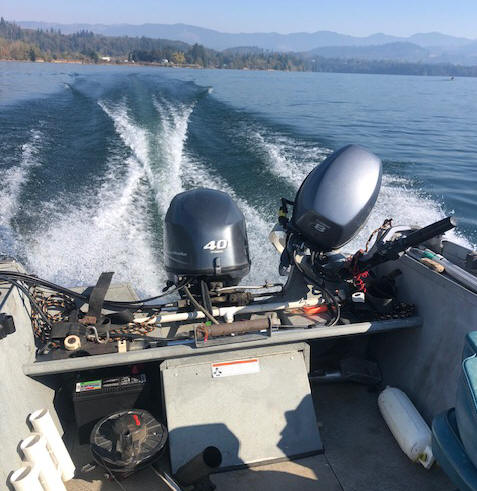 |
Console ;
Looking at this center starboard side steering console, (and again
storage in mind) I hatched the
idea of adding a inner shelf up under this console and down about 5"
from its
lower dash lip. However with
the steering gearbox input cable needing to have the shelf bottom cut
out to accommodate this cable, it became obvious that a single bottom
piece would be impossible to fit in, so I cut it in two, and with careful
fitting after making cardboard templates made it fit. This shelf is not
permanently installed just in case the steering cable may need to be
replaced. This shelf is pretty well protected and will provide minimal storage for the boat and
trailer registration, a spare key, battery voltage tester, binoculars, flash light, sling shot, fishing regs, cell phone,
snacks etc.
This registration/key container is simply a plastic Skippers cocktail
sauce jar with the lid screwed up under the inside of the console, making it waterproof
and compact.
The fire extinguisher was relocated to the front starboard
corner of the console, out of the way but ready.
| Here you see the console from inside with the self just showing | Here you see the console from outside |
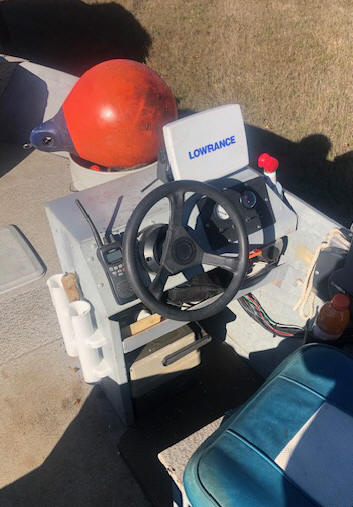 |
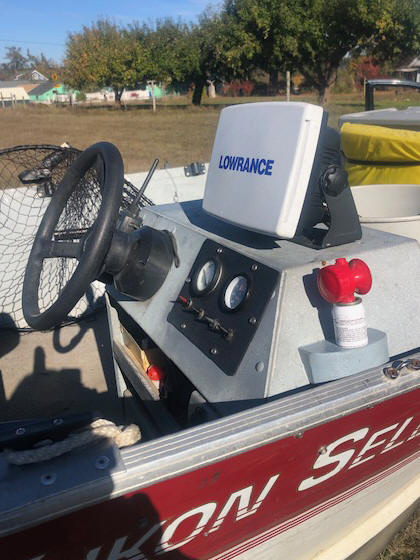 |
One thing to remember on boat building/rebuilding, NOTHING is square or level.
Originally this boat had a small switch/instrument panel on the starboard rear side panel. However as mentioned above, all the wiring was cut off under the splash well. This panel was an exact copy of a friend's Smoker Craft of near the same year as this boat, these both had 4 rocker switches with circuit breakers, power to panel/gas gauge, bilge pump, lights, live well (however it has no live well).
When I took delivery of it, the bilge pump was activated by 2 alligator clamps
onto the battery. The economy sonar was also using another set of
alligator clamps for it's power. I tired to trace out the cut wiring but
finally just gave up as it seemed that possibly some of the switches or resets
may have been defective or shorted out and that may be why they just cut them
all. This then gave me the opportunity, AND incentive to make a new
instrument panel, and moving it forward into
the console's dash.
OKAY, time for a complete rewiring job. Here I used the old gas
gauge, added a tachometer and 4 new toggle switches. To facilitate pulling new
wiring from the rear battery area to the console, I drilled a
1/2" hole at the very rear of the starboard side floatation panel and managed to run
a long welding rod fish-tape with a slight bend on the lower end down behind the
foam, and
managed to get it out the hole
below where the original wires had went through. Great, now I was
able to pull 4 new wires inside that side panel from the battery area, up along the Starboard gunnel
with the rest of the controls up and into the console. From this, I
was able to run a positive and a ground wire (negative) to the new panel, while the other
two wires were for the gas gauge and bilge pumps. The tachometer would be wired into the
Yamaha harness at the throttle/shifting control.
Update on the fuel gauge, upon removing the sender from the tank
and cleaning/testing it (which tested Okay), I ordered a new gauge,
thinking the old one was faulty.
Then installing it, it read 1/4 and I know it should have been 3/4+. Okay,
time to replace the tank sender with one that is compatible with the gauge's
resistance
(which I had ordered when I ordered the gauge, just in case).
The main power switch uses a inline 10 Amp spade fuse
on it's outlet wire, and it's wires are long enough that this holder can be
withdrawn enough for the fuse to now be
replaced without removing the instrument panel. To facilitate finding it
up underneath, a short cord attached to a foam key fob makes it more accessible.
This wiring is not what I like to see because of the limited
space up under this dash, it would be about impossible to use a fuse block with
individual fuses as there is not enough room for access. By this the only way
would be to prewire it on a board, then attach the board inside/under the dash,
Then the issue would be if a fuse would blow, it would be impossible to replace
it without removing the instrument panel (6 screws), and also near impossible to even
identify which fuse was blown because of the limited access. What I
have done was to identify (label) each hot wire (red or white) going to a
cluster at a large red wire nut. For the ground, all wires are black
and again using a wire nut, but green. These wires are not neat,
but just poked in with some semblance of necessity to hide them up and under
this dash out of the way as much as possible`.
Here is an experience that I am hesitant to share.
In installing the 4 switches in the new instrument panel, I thought I had
positioned all of them with the OFF position was UP. When I got all the
wires ran to the switches, I could not get power when I turned on the main
switch. I fought that for maybe 2 days, then finally ran a jumper wire
from the battery to the panel. Ground wire made no difference, then when I
ran the hot wire jumper, it was hot. I figured the new hot wire was
possibly defective. So I cut all the zip-ties on this wiring bundle, pulled the
(bad) hot wire and shorted it to the battery. SPARK. It was Okay ???
I pulled it back into the panel, connected all the hot wires using a (temporary)
electrical wire nut. Got power to the Sonar. What had gone wrong?
Had that input hot wire not made good contact in the wire nut connecter? Then I
noticed my main power switch on the panel was positioned in the OFF position.
What I had done was not positioned it in the same orientation as the others.
I had the wiring right for 2 days, but was flipping this main power switch to OFF,
thinking I was turning it ON.
One of the hardest wiring parts was to rewire up under the small bow deck. Who ever did this must have been a triple elbowed midget, (as the access was through a 7 1/2" X 11" hatch). Then to compound the issue, the wires were cut short. Trying to reach in at arms length, with minimal lighting, trying to connect these short 3 wires into a electrical wire nut by feel was conducive to muttering a few fowl words. Here the previous owner had installed bow/docking lights, but he had wired them into and in conjunction with the navigation lights, something I was not happy with. So I had to run a second set of wires and an individual switch for them.
Among the things that I also added to this console was a USB cell phone charger
outlet. This can also be used to recharge my VHF handheld radio.
I also added a CB/VHF hanging clip for
the handheld VHF radio on the dash just left of the steering wheel, so it will
be secure and readily accessible.
And it just so happens that my large fishing tackle box just fits under
this console, leaving the floor more open and uncluttered.
I also added a small wooden base made from 2" X 4" wood which a 1
1/2" hole was drilled 90% through to allow a mini size Freon horn a home,
screwing it onto the outer side of the console. Also in that area,
near the throttle/shifting controls,
but out of the way, I added a cup holder.
Sonar/GPS ;
Here I was gifted two Lowrance units, an old HDS5 that had never been updated
and a newer HDS7 Gen 2 that had some issues and the owner upgraded to a new
style Garman.
I chose the HDS7 as the data off the HDS7 on my North River should transfer to
this new to me one. And the issues he had with the previous owner would
probably not interfere with the usage that I would ask of it.
| Here you see the console |
 |
For a fish-box, I found that a Coleman 70 quart cooler fit
pretty well on the forward semi-deck up against the bow deck. This is held in
place by a long bungee cord around the upper section and between some aluminum angle
on the forward deck to help it's sideways stability.
Then to be in
USCG compliance, each boat has to have a throwable life cushion/preserver readily available.
Okay, why not place it rearward of the cooler and use the bungee cord to hold it in
place? This would make it out of the way and about as readily available as possible.
Then later I remembered that on my North River, I had a better throw line, which
I snatched for this boat.
This
is a 'Rescue Throw Rope' sold by West Marine.
It comes all contained in a small Nylon bag,
stuffed with 50 feet of 3/8" rope with a small float inside. Also on
this float bag is a handle, for use for a grab handle if you are throwing it to a person in the
water. The
protruding rope end has a loop that you slip over your wrist (preferably your
non throwing hand). You throw it underhanded like throwing horseshoes.
It is heavy enough making it easier/more accurate to throw, and
retrievable.
In the photo below, you can see the fishbox cooler/throw cushion, rear view of the Columbia
River anchor which is attached to the bow. And the rear of the (black) docking bow lights.
| Here you see the fishbox / throw cushion |
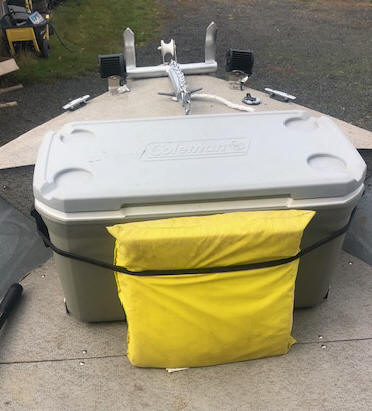 |
The rear swivel seat was originally stationary, which I removed and
attached this folding seat onto a swivel base 4 legged chair. On my
previous swivel chairs, I have welded a 3/4" angle iron frame onto the legs up
about 5 ", and
installed a stainless or aluminum expanded metal bottom, so that no water would
accumulate. This also is again a close catch-all during fishing.
Needless to say I did the same to this chair base.
| Here you see the new swivel chair catch-all tray |
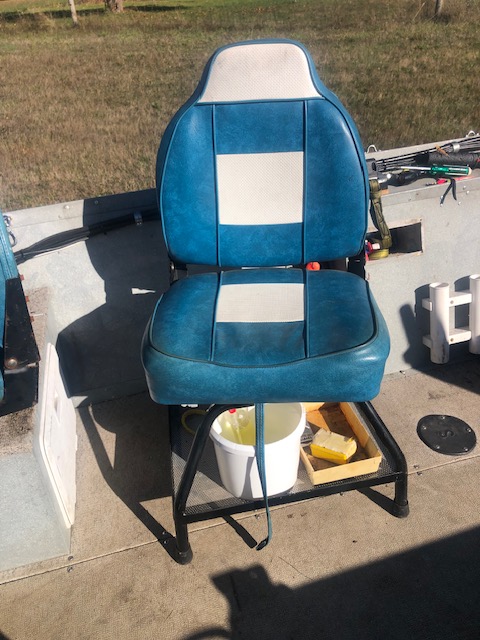 |
The Columbia River anchor system (which entailed a18# rocker type anchor)
consisted of 140 feet of
3/8" anchor line which was contained in a 5 gallon plastic bucket.
Since it takes up considerable room along with the 15" puller float, this long a line will not be utilized
very often, it has been replaced by a 3 gallon bucket which contains 75 feet of 7/16"
nylon rappelling line. On these systems, the anchor itself is not attached until
it is decided which type of fishing will be done that day, so an simple exchange
of buckets works quite well.
| Here you see the large anchor line bucket with float | Here you see the small anchor line bucket |
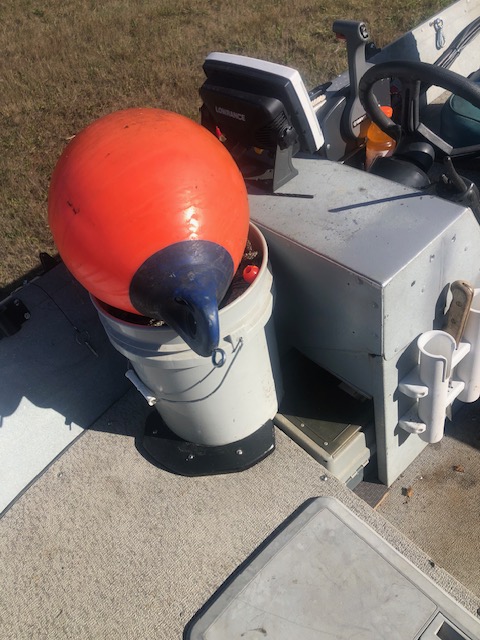 |
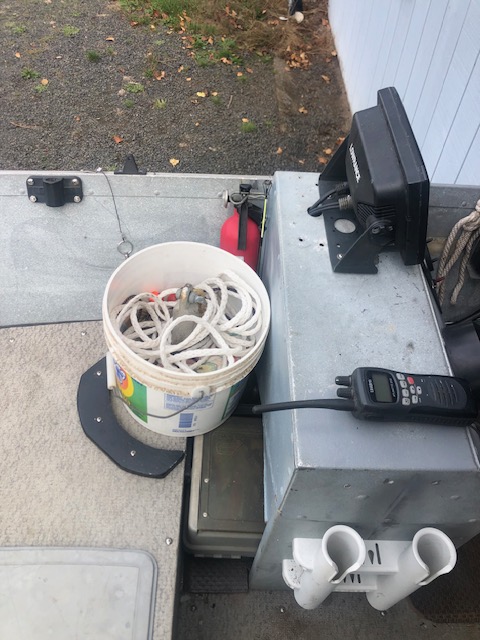 |
Motors ; Normally, I sit on a swivel chair at the rear to steer
the trolling motor using it's tiller, just something I have done for many years. However at times it can be beneficial to steer the smaller
trolling motor from the helm. This was accomplished by welding a 3/8" stainless
steel nut to the main motor's cable linkage bar as seen in the photo below.
This has a quick disconnect tie bar to be connected from the 8hp to the 40hp,
which will also allow either motor to be raised without removing the tie bar.
And this connector rod can readily be disconnected.
Guess what, if you are thinking about doing any of your own maintenance, even
changing the spark plugs, you will need a special 18mm thin wall deep socket, and I
suggest it being a 3/8" drive. You will also need a short 2" extension,
along with
a universal joint, especially access for the bottom plug. A suggestion is when
replacing these spark plugs, start them in the threads by hand to ensure you DO NOT get them
cross-threaded. Then the bottom plug has a tendency to fall out of
the socket upon removal of you are not careful (because of the universal joint) and is about impossible to retrieve by hand, where a
long handled magnet is a great help. And if you are thinking of checking
compression, these spark plug threads are 12mm (more the size of motorcycles), not the
more standard 14mm.
One thing that I am strongly considering later on is to add a
power tilt conversion to the 40 hp motor. This motor currently is manual
tilt, but is designed so that the nitrogen shock (that lets it down slower, or
locks it in any position) can
be replaced with a power unit. And if I am to run shallower river
water, it may be VERY BENEFICIAL to be able to lift the lower unit up at times
simply by
pushing a button. Then when about all the other modifications were
finished, I did purchase and installed a new electric hydraulic tilt conversion.
However I took it to a marine mechanic for the electrical as this non power tilt motor
needed electrical up/down relays, so I just let them supply and finish that
installation.
The 8hp already has this as it was designed with it's own power tilt.
| Here you see a tie bar from the main motor's steering cable system to the trolling motor | |
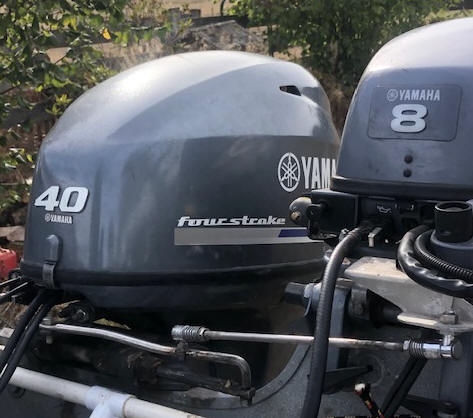 |
Then I just happen to have an older Minn Kota 45# thrust electric trolling
motor that I purchased years ago, that can be mounted on the Starboard side on the transom and yet be able to clear
the transducer. This should be helpful on a day somewhere in the future (like backtrolling
for Steelhead/drifting/casting spinners for river Coho). Here I run an extra 12 Volt marine battery for it's power as to not drain
my main power battery, leaving me stranded. This battery is secured
under the port splash tray by a bungee cord.
| Here you see the electric trolling motor |
This boat has a 17 gallon fiberglass under the floor fuel tank. Apparently the
trolling motor was added separately, as the it was not
plumbed for it's own fuel line, where they shared a common fuel line, and the
only way it could be ran was to disconnect the fuel line from the larger motor
and use it on the smaller motor. That may be OKAY for trout or
crappie fishing, but on larger faster moving water that I plan on exploring, if $hit happens, the
almost immediate usage of
the second motor can be a life saver. Hence, it is now plumbed one
fuel line off the main tank for each motor.
However there is no main water/fuel separator (not a lot of room there).
I have also installed hour meters on both motors, which will help me keep track of
run time, and for oil changes. These are the simple little black box with
a wire running to be wrapped around a spark plug wire.
In the photo below you see the inner rear parts of this boat,
with the center hinged lid raised for access to the bilge pump and fuel gauge
sender. The series 24M marine battery is on the left. On the right is the fuel
line filler and vent hoses.
| Here you see the transom area with the motors and with the center lid raised |
 |
Looking at the chewed up prop on the motor (and the 2 spares that the previous owner gifted me), made me consider some kind of prop guard. I had my welder friend weld up the bad prop dings, and I refinished the surfaces and repainted them, one to use and the others as a spare.
And the
areas that I plan on frequenting can have sand/gravel bars and even logs. Okay,
online I saw the Hydro-Shield product which looked interesting. I had the
ability, so I somewhat copied this idea, but made
mine out of 3/16" aluminum. However this type of guard only attaches to
the skeg, not both the skeg AND the cavitation plate as others do. This 40 hp motor
has in it's past probably had a couple of the latter prop guards installed as
evidenced by all the holes. So before going to far, I had my welder
friend weld up the existing 3 holes in the skeg, as with me adding 3 more (which
would be near impossible to locate the new guard into accurately) it would look like
Swiss cheese and be weakened considerably.
I also have a hoop type prop guard on the T8 trolling motor,
which I made years ago, copying a commercially made Macs, and made of stainless steel,
which works quite well.
| Here you | Here you see the prop guard for the trolling motor |
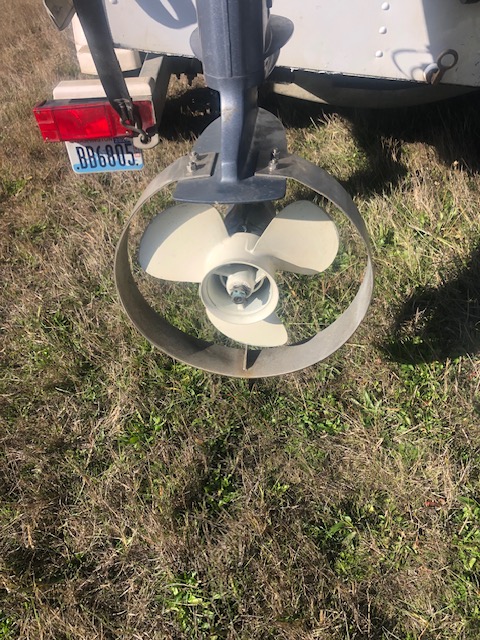 |
The under the rear splash well on the Starboard side is where
the marine battery is located. However space is limited and the series 27
battery that came with the boat is too long to fit sideways under this well.
Therefore the battery has to be inserted lengthwise, taking up room forward of
this opening. Hence I purchased a series 24 shorter battery which can now be slid
in sideways. I will retain the series 27 battery for usage with the Minn
Kota electric trolling motor.
There is a similar space on the Port side, but it is not as usable because the fuel tank filler hose and vent line takes up a lot of usable space there. In the center between these is a 20" wide hinged lid giving access to the bilge pump, fuel tank fittings and drain plug areas, but with no provision for lifting it, so I simply added a knob on the Port side, and a stick to prop it open.
| Here you see the battery compartment | Here the fuel line Tee to both motors with the fuel tank sender in the foreground with the bilge pump buried to the left of the center brace |
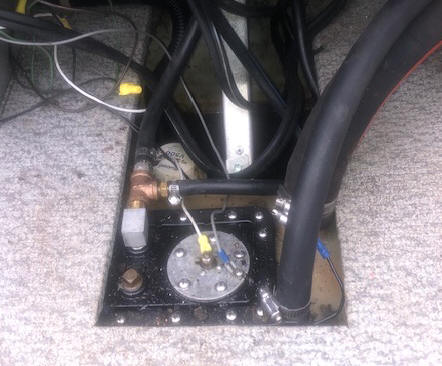 |
Bilge Pump ;
In my rewiring in the battery area for the bilge pump and fuel gauge,
the bilge pump was not attached to anything other that it's outlet hose,
it was just laying there on it's side in the bilge. Okay,
while I was there doing the rewiring, I might as well pull the pump out and
make a mounting bracket for it. When I got it out, there was a LOT of debris in
the bilge there, like sand, rocks, a conduit strap, bolts, nuts, a glass
fuse, and a unidentifiable small coin.
This pump motor can be rotated, allowing it to separate from the
pump body, giving access to the pump
itself. WOW, lots of sand, so much that my guess the pump if it
was operative, would possibly not have enough force to even get any
water overboard. And of course since it was so old that the
twist lock plastic retainer prongs broke off during disassembly, which I did not notice until time to
reinstall it. Good old Duct Tape to the rescue again.
Since there is no wash-down pump on this boat, nor room to
install one, therefore I use a 1 gallon painters plastic bucket, which I
tie about 2' of 5/16" Nylon line with a large loop in the outer end as a
hand hold, which helps for dipping water and no loosing the bucket.
It can be stored in the rear movable seat tray which secures it out of
the way.
Rod Holders ;
Here, Fish-On bases were possibly mounted fine for fishing at trout anchor, but
woefully in wrong places for salmon trolling. And most of them were
only retained by two self-tapping #14 screws into the gunnel. But I had lucked out
at a yard sale a few weeks before, purchasing 3 sets of these rod holders (complete with
bases) for $6.00 total.
This boat came with a triple vertical rod holder mounted on the starboard
inner rear panel rearward and below the old instrument pane, which I tried to remove and
reinstall forward on the inner side of the console, but it was SECURELY glued in
place, so I left it there, but found a dual holder for that forward installation.
| Rod holders |
Downriggers ;
There were unknown brand bases for downriggers, which were mounted in the rear
side shelf, but not enough forward for the fisherperson to stand
rearward of them to operate effectively. I had let my Scotty electric model
downriggers go with my larger boat when I sold it, but
I had picked up a couple
of used Scotty manual versions as backups, so these will find a home here when that time comes, as I
have installed bases to accommodate them.
For these bases, I have added Cannon low profile swivel plates under the
Scotty bases, which provides easy access to multi positioning the downrigger
in any position at deployment time or rotated rearward while landing a
fish or moving from
one location to the other. Here I had to add a 3/8" aluminum adapter
plate between the two, to accomplish this.
| Here you see one of the manual downriggers mounted. Note my nylon tether in the slot of the base adapter | Here you see the tether attachment welded onto the downrigger adapter base |
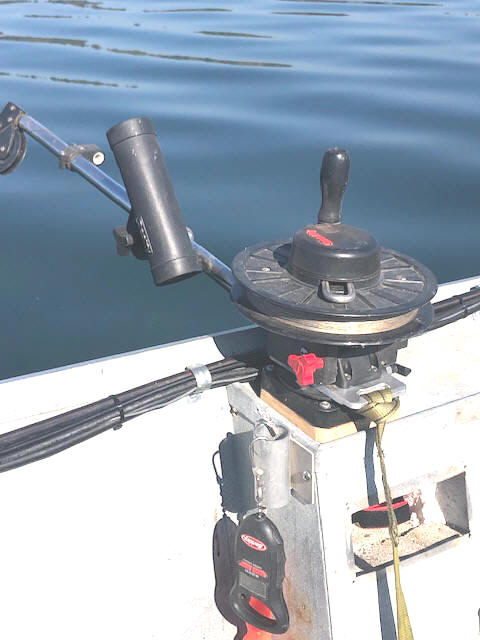 |
 |
I always wear an "Offshore" inflatable life vest when I am on the water.
These vests have double Dee rings (one on each side) in front where, when
fishing alone, I snap a 10' Nylon web strap which has a quick release onto
these Dee rings. As an afterthought, I then made a shallow 1/4" aluminum U shaped anchor point that
was welded onto this downrigger aluminum adapter plates, (as seen in the RH
photo above) that will be my tether anchor to
the boat, as seen in the above photo. This way it (this anchor) is out of
the way, permanent and can be
used even if the downrigger was being used.
Launching Solo ;
When launching solo, there are issues that are completely different than with a
partner. Who holds onto your bow line at launch time? I have developed a
method where my bow line is at least 6' longer than the trailer. I have
installed a larger mooring cleat to the trailer winch upright, to which I attach
the bow line to at launch time. Here, after removing the winch hook, I back down the ramp,
remove the trailer safety chain, back farther, submerging the boat enough to where most of it is
floating, keep backing a bit, hit the brakes and float the boat off the trailer.
Now I gently pull ahead, taking up the slack in this bow line which of course is also
attached to the bow of the boat. As the floating boat reaches the end of the line, the boat
stops it's rearward motion and follows the trailer back to the waters edge of
the launch like
a well trained puppy. I can then secure it (the boat) to the bank (with a
small river anchor) or tie it to the dock
and drive up and to park the trailer.
One thing that I found was THIS bow line was new 3/8" hollow
core Polypropylene, of which you can open up the weave and insert the tail of the
eye into the hollow weave, which then acts as a Chinese finger stall, making a
neat eye splice. However this particular line was stiff enough (or
the weather was cooler) that
it did not grip the tail well enough (being so new) so that under strain, the eye pulled out.
Luckily not before it stopped the rearward motion of the boat and started it
back toward the launch. My remedy was to use a couple of small Zip ties
into and through both the inner and outer parts of the line, securing them
better.
|
Here you see the solo bow line retainer
cleat with the white line attached to it |
|
 |
The Trailer ;
The trailer's passenger side had been backed into and the
taillight assembly was held in place by a small dia. cord. And it's
metal mounting bracket was badly bent. Along with the boat was sitting too far
forward by possibly 5", (either caused by this accident or power loading) to where the winch mount
needed to be repositioned rearward. At this time, I also relocated the tongue
mounted crank farther forward of the winch mount.
With this repositioning, I now mounted on the port side of
the tongue a 6" X 34" aluminum expanded metal catwalk that I salvaged
from a scrap bin, for help in loading
if need be. This was attached to the tongue using existing bolts
that secure the winch support and the spare tire bracket on the front
and middle. The rear section lays on top of the trailer side frame
and is bolted to it.
| Here you see the trailer catwalk |
 |
The rear bunk side loading guides were short and rather low, creating a loading
issue if in a cross wind or tidal current if the trailer happens to be
a little to deep in the water. Some guides are 3 times this long,
depending on the boat or trailer involved. These were a single
mount on the rear trailer cross-frame and were only 26" long.
After sleeping on finding a solution, I decided to simply raise the
guides by adding a spacer between the base and the guides. In
searching for a metal, I found a scrap 3/16" X 18" aluminum that I
was able to make two 7" high plates, which raised the guides by 5".
But the base was not at a
true perpendicular angle for some reason, (tipped outward a bout 10
degrees) so I had to add a slight bend
in these plates pulling the guide closer to the boat to compensate, this method was a lot easier than
removing and bending these
bolt on bases.
These guides are especially useful when loading at a launch where there is no
dock. In use with the trailer backed into the water, usually with
the fenders 3" showing about above the water. When bucking a wind or
current, it is about impossible to power load coming in straight onto
the trailer. You have to compensate for the wind, coming in
at a angle, the turn onto and straight with the trailer (not an easy
task). With these side guides, you slowly nose the bow into the wind and inward against the
upstream guide. Ease in with little power against this side guide
which allows you to pivot the boat's bow more in line with the trailer,
and then when more aligned, add some power to partly load.
If you find the right combination, these guides effectively guide the boat more aligned onto the
trailer. Once it is straighter, more power and you can run
it up farther forward. If you need to straighten it a bit, just use the
motor to compensate slightly pivoting the stern on the trailer, centering it,
more power and into the Vee on the winch stand. Then you can get
off the boat, attach the winch hook to the boat's bow eye and tighten it
into the Vee, attach your safety chain and drive up the ramp.
After using this boat in launching/recovering at both a dock
and a river (where the current was running) these extended guides help
tremendously.
| Here you see the new raised trailer side bunk guides |
 |
Then when I was checking the tires for air pressure, I found
that the spare tire had no valve stem core. So it would have been
completely flat if it was needed.
Then the wheel bearing covers are not "Bearing Buddy" type
which are way better in lubricating the bearings, but have just the "dust
cover" type on it. Time for another change, which I did not pull
and inspect the bearings as they felt good in rotating the tires and
after spinning them they continued to rotate for a while. Along
with the fact that I have been crowding into the Coho salmon run in the
estuary/lower rivers, so this winter will attend to that matter.
And in doing this adding the Bearing Buddys, the rims needed a paint
job, along with one was a odd-ball, so it is now the spare.
Guess what, the old spare that was missing the valve stem core, (which i
replaced) well
that was not all that was wrong, after airing it up and now on a wheel,
it was flat again a week later. Time to head for a tire shop before a flat
happens on
the road.
When I got it to the tire shop it was still swished flat on
one side, and when they aired it up, they could not find any leaks ????
This tire is brand new, as it still has the small rubber needles
protruding on the tread along with a blue stripe around the center of
the tread. It matches the other two tires so apparently all three were
replaced at the same time. The ones on the axle have not
been ran a lot as they still have LOTS of tread.
As a FYI on repainting the rims, instead of masking off the tires, I
found an old lampshade, cut it off so there was about 3" left on the
lower edge, which allowed me to fit it on the tire outside of the rim,
where I could get a good paint coverage with no overspray.
And during this trailer repair, I found that the lights are
sealed beam, which is a good thing.
So needless to say it took me more than a couple of weeks, repairing and
remodeling before I got it close to getting it wet, and even before I got the
registration changed.
Shakedown Cruse ;
OKAY, 2 1/2 weeks of remodeling/fixing, I finally had shakedown cruse.
I am pretty happy with the outcome, however we did found a few modifications
were needed (like the one rod holder that I had not moved, really needs to be
moved to accommodate the tiller handle of the T8 motor).
This main motor had no out of the hole power, as the previous owner was looking for speed, where I am looking for utility, so his highly pitched prop will have to go.
His sonar would not function, even though I tried it previously, so time
to replace it with a used Lowrance HDS7, which I can transfer all of my
waypoints into off my North River boat's Lowrance HDS7.
And on this trip, we had what appears to be a intermittent lack of
fuel supply issue on the main motor. Pumping the primer bulb while this
was happening did nothing,
indicating the fuel pump was probably not the issue. But when I got it
home, I removed the onboard fuel filter, which did not look really that bad,
but I
ordered two (for $10.49) a new one and have now installed it. I begin to
wonder if that may be what the previous owner sold the boat, thinking the motor
was going bad.
And I even caught a Coho salmon on this trip.
Second Trip ;
OKAY another month had passed.
Needless to say, this boat took a lot more work
on than I had expected. But I am told that I am a perfectionist and do not
do anything only half done. However it seems to be something that I do enjoy,
being able to finding an issue, and then being able to solve it, and it keeps me
busy. And at my age, the chase seems just as important as the catch. I
just wish I had kept track of the number of times that I climbed aboard in
doing these repairs.
This second trip was more of a test run to verify the
starving for fuel issue with the main motor was just a plugged fuel filter
(which I had replaced). I took it to a nearby electrical power reservoir,
and gave it a 20 minute run. It ran at all speeds without any hiccups. This partly
convinced me that the previous owner was probably also having starving issues
also but had not thought about the filter. But what really
solidified this thought was I later remembered when I bought it, there was a new
fuel line coupler that he gave me, saying "you might be able to use this
sometime". That added to the rest that I now know has convinced me
he had issues and thought maybe the fuel line coupler to the motor may have been
sucking air, especially when I primed the fuel filter (using the primer bulb), I
got a few drips of gas at this old coupler. He had possibly been
there, and again, very likely had been having this fuel issue also. I am now
pretty sure that is why he sold the boat.
Thinking back, of all the boats that I have owned, VERY FEW
did not have some kind of an issue at the time of the purchase. And
here I
am not counting any improvements that I made afterwards.
I am very happy with the final results of this boat. It
handles like a dream, and for being 2 feet shorter, it actually has more fishing space than
my longer North River. There are a few things yet to get up and going, like the
fuel gauge and the tachometer, but it is now USCG compliant and totally fishable.
These other issues will be addressed during the winter, along with I will make a couple of fiberglass rear side inserted storage
compartments. And I may pull the floor over the fuel tank and inspect it
as there are two unknown wires protruding from under it at the rear. Along with maybe adding
a small Plexiglas windshield.
By now you have probably decided that I don't go part way in
rigging my boats and that it is important to have even small things operational.
Some smart person once said "95% of successful fishing is done the night before".
In my mind this also pertains to having your boat totally ready, "everything has
a place, and in it's place".
Miscl & Other Helpful Things ; Here you will see little things that I add to my boats which assist me during an outing. (1) As shown above the movable swivel chair with a catchall tray underneath. (2) A removable foam leader spool holder. (3) A removable aluminum catchall tray used in conjunction with #2. (4) A mini gaff type hook that is used to secure salmon after they are on the deck, and to carry them to the fishbox. (5) A tuna cord fish bleeder line using a combo toggle arm on the lower end that also functions as a gill cutter. (6) Scent bottle holders. (7) A push pad that attaches to the removable hook end of a extendable boat hook. (8) Quick docking tether for mid mooring cleat. (9) A net minder for the landing net. (10)
| Here you see the |
This Page Under Construction
Copyright © 2025 LeeRoy Wisner
All Rights Reserved
Back to the Main Ramblings Page
Originated 08-30-2025, Last updated 11-05-2025